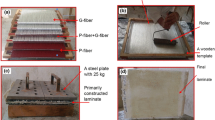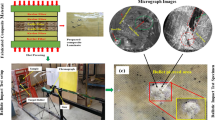Abstract
In this study, both Flatwise and Edgewise Charpy impact behavior and the effect of high strain rate of foreign object’s shape on the energy absorption, delamination, and failure mechanisms of biodegradable hybrid composites (BHCs) were investigated. The Kenaf–Cotton (KCCK) composite specimens were made using a hand layup method, consisting of four layers of Kenaf and Cotton woven fibers (0/90) in a PLA matrix which accounted for 76% of fiber volume fraction. In high strain rate tests, two different types of projectile’s shapes namely Flat and Ogival were used. Based on the results, the KCCK specimens under Edgewise impact loading absorbed the most energy compared to their Flatwise counterpart by 75%. Furthermore, the Charpy tests revealed that the Flatwise specimens exhibited only minor deflection and surface cracks at the impacted zone, while the Edgewise specimens suffered significant delamination between the outer layers. As a result of projectile geometry in high velocity loadings, the maximum effect on specimen behavior occurred within the ballistic limit. Within this range of velocities, the projectile with a Flat nose had the worst ballistic performance with a ballistic limit velocity (17.8%) greater than the projectile with an Ogival nose.
















Similar content being viewed by others
Notes
1 Caliber Radius Head.
References
Pertegas SL, Anusic A, Resch K, Schledjewski R (2016) Green composites: challenges to reach high performance components. In: 17th European conference on composite materials ECCM17. Munich
Morreale M, Liga A, Mistretta MC, Ascione L, La Mantia FP (2015) Mechanical, thermomechanical and reprocessing behavior of green composites from biodegradable polymer and wood flour. Materials 8(11):7536–7548
Gupta NK, Iqbal MA, Sekhon GS (2007) Effect of projectile nose shape, impact velocity and target thickness on deformation behavior of aluminum plates. Int J Solids Struct 44(10):3411–3439
Mohammadi I, Haghighi-Yazdi M, Safarabadi M, Yousefi A (2023) Crashworthiness analysis of a composite guardrail under impact loading. Proc Inst Mech Eng Part L J Mater Des Appl 23:14644207231152432
Isaac CW, Ezekwem C (2021) A review of the crashworthiness performance of energy absorbing composite structure within the context of materials, manufacturing and maintenance for sustainability. Compos Struct 1(257):113081
Hedayati R, Yousefi A, Bodaghi M (2022) Sandwich structures with repairable cores based on truncated cube cells. Compos B Eng 15(243):110124
Iremonger MJ, Went AC (1996) Ballistic impact of fibre composite armours by fragment-simulating projectiles. Compos Part A Appl Sci Manuf 27(7):575–581
Mines RA, Roach AM, Jones N (1999) High-velocity perforation behaviour of polymer composite laminates. Int J Impact Eng 22(6):561–588
Mitrevski T, Marshall IH, Thomson R, Jones R, Whittingham B (2005) The effect of impactor shape on the impact response of composite laminates. Compos Struct 67(2):139–148
Naik NK, Shrirao P, Reddy BC (2005) Ballistic impact behaviour of woven fabric composites: parametric studies. Mater Sci Eng A 412(1–2):104–116
He T, Wen HM, Qin Y (2008) Finite element analysis to predict penetration and perforation of thick FRP laminates struck by projectiles. Int J Impact Eng 35(1):27–36
Icten BM, Kıral BG, Deniz ME (2013) Impactor diameter effect on low velocity impact response of woven glass epoxy composite plates. Compos B Eng 1(50):325–332
Jordan JB, Naito CJ (2014) An experimental investigation of the effect of nose shape on fragments penetrating GFRP. Int J Impact Eng 1(63):63–71
Kalthoff JF (2004) Characterization of the dynamic failure behaviour of a glass-fiber/vinyl-ester at different temperatures by means of instrumented Charpy impact testing. Compos Part B Eng 35(6–8):657–663
Özbek Ö, Bozkurt ÖY, Erkliğ A (2020) Low velocity impact behaviors of basalt/epoxy reinforced composite laminates with different fiber orientations. Turk J Eng 4(4):197–202
Ochi S (2008) Mechanical properties of kenaf fibers and kenaf/PLA composites. Mech Mater 40(4–5):446–452
Cao Y, Shibata S, Fukumoto I (2006) Mechanical properties of biodegradable composites reinforced with bagasse fibre before and after alkali treatments. Compos Part A Appl Sci Manuf 37(3):423–429
Bax B, Müssig J (2008) Impact and tensile properties of PLA/Cordenka and PLA/flax composites. Compos Sci Technol 68(7–8):1601–1607
Rubio-López A, Artero-Guerrero J, Pernas-Sánchez J, Santiuste C (2017) Compression after impact of flax/PLA biodegradable composites. Polym Test 1(59):127–135
Wang LN, Guo Wang PY, Wei JC (2017) Graphene oxide-graft-poly (l-lactide)/poly (l-lactide) nanocomposites: mechanical and thermal properties. Polymers 9(9):429
Favre HA, Powell WH (2013) Nomenclature of organic chemistry. Royal Society of Chemistry, London
Beigpour R, Shokrollahi H, Khalili SM (2021) Experimental and numerical analysis of a biodegradable hybrid composite under tensile and three-point bending tests. Compos Struct 1(273):114255
Recht RF, Ipson TW (1963) Ballistic perforation dynamics. J Appl Mech 30(3):384–390
Pandya KS, Akella K, Joshi M, Naik NK (2012) Ballistic impact behavior of carbon nanotube and nanosilica dispersed resin and composites. J Appl Phys 112(11):113522
Yeganeh EM, Liaghat GH, Pol MH (2015) Experimental investigation of cylindrical projectiles nose shape effects on high velocity perforation of woven polymer composite. Modares Mech Eng 14(14):308
Cunniff PM (1992) An analysis of the system effects in woven fabrics under ballistic impact. Text Res J 62(9):495–509
Bavasso I, Sergi C, Valente T, Tirillò J, Sarasini F (2022) Recycled multi-material packaging reinforced with flax fibres: thermal and mechanical behaviour. Polymers 14(20):4423
Sergi C, Tirillò J, Valente T, Sarasini F (2022) Effect of basalt fibres on thermal and mechanical properties of recycled multi-material packaging. J Compos Sci 6(3):72
Mahesh V, Joladarashi S, Kulkarni SM (2018) Suitability study of jute-epoxy composite laminate for low and high-velocity impact applications. In: AIP conference proceedings. New York, pp. 020106–7
Beigpour R, Khalili SM, Shokrollahi H (2022) Lightweight biodegradable hybrid composite sandwich panel under three-point bending loads—experimental and numerical. Polym Compos 43(11):8007–8029
Funding
This research work was done on self-fund bases.
Author information
Authors and Affiliations
Corresponding author
Additional information
Technical Editor: João Marciano Laredo dos Reis.
Publisher's Note
Springer Nature remains neutral with regard to jurisdictional claims in published maps and institutional affiliations.
Rights and permissions
Springer Nature or its licensor (e.g. a society or other partner) holds exclusive rights to this article under a publishing agreement with the author(s) or other rightsholder(s); author self-archiving of the accepted manuscript version of this article is solely governed by the terms of such publishing agreement and applicable law.
About this article
Cite this article
Khalili, S.M.R., Beigpour, R. & Mahajan, P. Strain rate dependency of lightweight hybrid green composite laminate-an experimental study. J Braz. Soc. Mech. Sci. Eng. 45, 283 (2023). https://doi.org/10.1007/s40430-023-04221-x
Received:
Accepted:
Published:
DOI: https://doi.org/10.1007/s40430-023-04221-x




